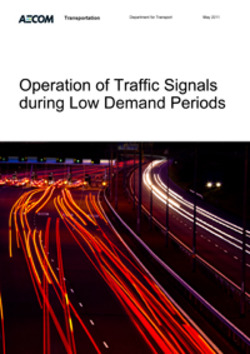
Organisation: Department for Transport
Date uploaded: 24th October 2012
Date published/launched: October 2012
This study aims to assess and recommend potential alternative techniques that could be applied at signal-controlled junctions in the UK during periods of low demand.

This study was commissioned to investigate, assess and recommend potential alternative techniques that could be applied at signal-controlled junctions in the UK during periods of LD.
The objectives of this desktop study are to investigate options for signal controlled installations that will help:
• Reduce unnecessary delays to traffic, hence minimising overall vehicle delays and emissions.
• Reduce the energy consumption of signal installations.
• Maintain or enhance levels of safety, especially for vulnerable road users.
Key conclusions
The study found potential options that achieve the first objective – “prevent unnecessary delays to traffic, hence minimising vehicle delays and emissions’. The design of traffic signal controlled junctions generally concentrates on periods of heavy demand, maximising capacities and providing facilities for all users of the junction. There is a tendency to assume that the same control strategy will suffice for all other periods, although this frequently imposes unnecessary delay on users,
increasing emissions and journey times as well as driver frustration. By careful study of individual installations or wider networks, it should be possible to minimise these non-peak delays whilst maintaining safe operation.
For more information contact:
Department for Transport enquiries

No details are given as to whether certain methods may be safe and effective and others not, or of criteria for selection of appropriate applications of the available methods. This may be contained within the main report, but the summary itself provides little useful information.